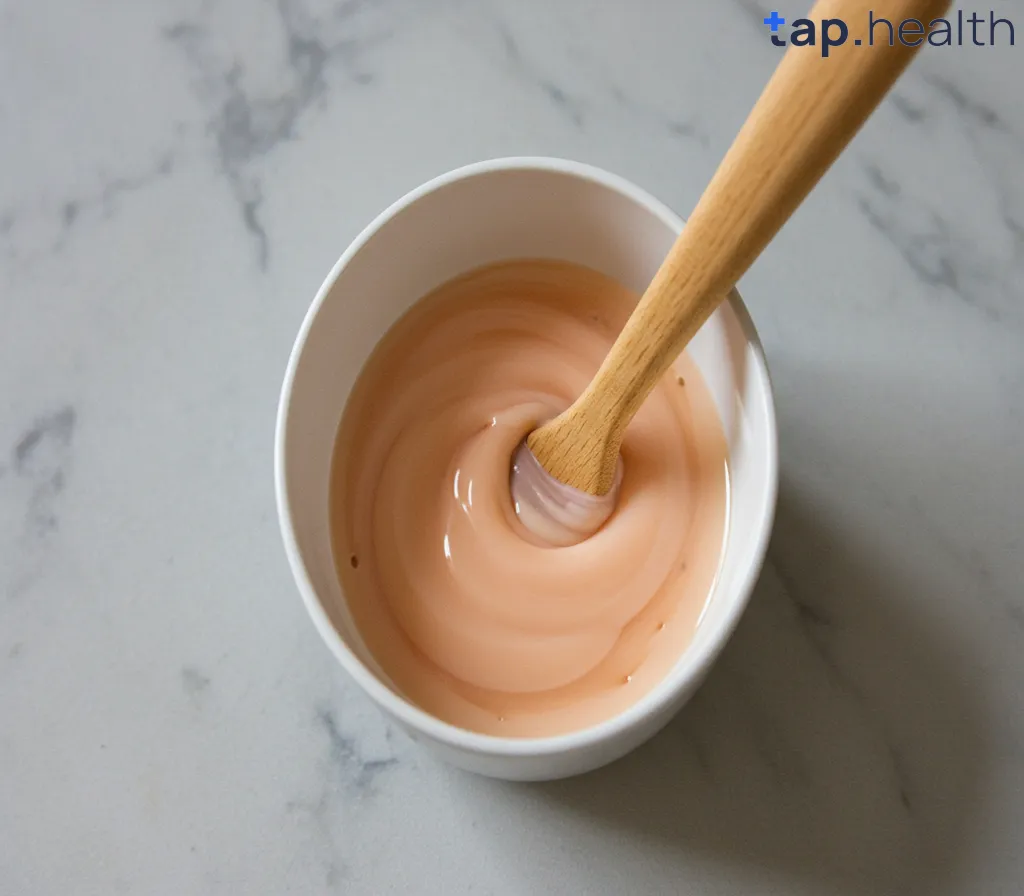If you’re into skincare, you’ve probably heard of glycolic acid and vitamin C. They’re two of the most popular ingredients in skincare products today. Glycolic acid helps exfoliate your skin, making it smoother and brighter. Vitamin C is famous for brightening your complexion and fighting signs of aging.
But here’s the big question: Can glycolic acid be used with vitamin C?
The short answer is: Yes, but with caution.
You can use both ingredients in your skincare routine—but how and when you use them matters a lot. Using them the wrong way can irritate your skin, cause redness, or even damage your skin barrier.
In this guide, we’ll break down everything you need to know about using glycolic acid and vitamin C together. We’ll cover:
- What glycolic acid and vitamin C do for your skin
- Whether it’s safe to mix them
- The best ways to use them (morning vs. night, same routine or separate)
- Who should avoid using them together
- Common mistakes people make
- Expert tips for getting glowing, healthy skin
Let’s dive in.
What Is Glycolic Acid and How Does It Work?
Glycolic acid is a type of alpha-hydroxy acid (AHA). It comes from sugar cane and is one of the most effective exfoliants in skincare. Because its molecules are very small, it can easily penetrate the top layer of your skin.
How Glycolic Acid Helps Your Skin
- Exfoliates dead skin cells: It gently removes the outer layer of dead skin, revealing fresher, smoother skin underneath.
- Improves skin texture: Regular use can reduce rough patches and make your skin feel softer.
- Fades dark spots and acne scars: By speeding up cell turnover, it helps lighten discoloration over time.
- Unclogs pores: This can help prevent blackheads and acne.
- Boosts collagen production: Over time, it can help firm the skin and reduce fine lines.
Glycolic acid is found in cleansers, toners, serums, and peels. It’s great for people with dull skin, acne scars, or signs of aging.
But because it’s strong, it can make your skin more sensitive—especially to the sun.
What Is Vitamin C and Why Is It So Popular?
Vitamin C (also called ascorbic acid) is a powerful antioxidant. It’s not just for colds—it’s also a skincare superstar.
Benefits of Vitamin C for Skin
- Brightens skin tone: It helps fade dark spots and gives your skin a healthy glow.
- Protects against pollution and UV damage: As an antioxidant, it fights free radicals that harm your skin.
- Helps with collagen production: This keeps your skin firm and reduces wrinkles.
- Reduces redness and inflammation: It can calm irritated skin and improve acne.
- Improves overall skin health: Regular use leads to smoother, more even-toned skin.
Vitamin C is usually found in serums, moisturizers, and face oils. It works best when applied in the morning because it boosts your skin’s defense against sun damage.
But like glycolic acid, vitamin C can be strong—especially in high concentrations.
Can Glycolic Acid Be Used With Vitamin C?
Now, the main question: Can you use glycolic acid with vitamin C?
Yes, you can use them together—but not necessarily at the same time.
Think of it like this: both ingredients are powerful. Using them together without care is like putting two strong cleaners in the same bucket—they might cancel each other out or cause a reaction.
Let’s look at the science.
Why Mixing Them Can Be Tricky
- pH Levels Matter
- Glycolic acid works best at a low pH (around 3–4).
- Vitamin C (especially L-ascorbic acid) also needs a low pH (around 2.5–3.5) to be effective.
- When you mix them, the pH can shift, making one or both less effective.
- Irritation Risk
Both ingredients can irritate the skin, especially if you have sensitive skin. Using them together increases the chance of redness, dryness, or peeling. - Stability Issues
Vitamin C is unstable and breaks down easily when exposed to light, air, or other active ingredients. Mixing it with glycolic acid may reduce its shelf life and effectiveness.
So, while they can be used in the same routine, experts usually recommend not applying them at the same time.
Can You Mix Glycolic Acid and Vitamin C in the Same Routine?
Yes—but you need to be smart about it.
You don’t have to give up one to use the other. You just need to space them out.
Here are the best ways to include both in your skincare routine safely.
Option 1: Use Vitamin C in the Morning, Glycolic Acid at Night
This is the most common and safest method.
- Morning: Apply vitamin C serum after cleansing. It protects your skin from sun damage and pollution all day.
- Night: Use glycolic acid to exfoliate and renew your skin while you sleep.
This way, each ingredient works at its best without interfering with the other.
Option 2: Use Them on Alternate Days
If your skin is sensitive, you might want to use them on different days.
- Monday: Vitamin C in the morning
- Tuesday: Glycolic acid at night
- Wednesday: Vitamin C again
- And so on…
This gives your skin time to recover and reduces the risk of irritation.
Option 3: Use a Product That Already Combines Them (Carefully)
Some skincare brands make products that contain both glycolic acid and vitamin C. These are formulated to be stable and safe.
But be cautious:
- Check the concentration.
- Start slowly (2–3 times a week).
- Watch for signs of irritation.
If you’re new to either ingredient, it’s better to use them separately at first.
What Happens If You Use Glycolic Acid and Vitamin C Together?
Using them at the same time doesn’t cause a dangerous chemical reaction, but it can cause problems.
Possible Side Effects
- Skin irritation: Redness, stinging, or burning
- Dryness and peeling: Especially if you have dry or sensitive skin
- Increased sun sensitivity: Both ingredients make your skin more vulnerable to UV rays
- Reduced effectiveness: The pH clash may make vitamin C less potent
You might not notice issues right away, but over time, your skin barrier can get damaged.
Real-Life Example
Imagine you apply a glycolic acid toner, then layer a vitamin C serum on top. Your skin might feel tight, look red, or start flaking. That’s your skin telling you it’s too much.
Instead, if you wait a few minutes between layers (or use them at different times), your skin handles it better.
Who Should Avoid Using Glycolic Acid and Vitamin C Together?
Not everyone should use these two ingredients—even if they’re used at different times.
People With Sensitive Skin
If your skin burns, itches, or turns red easily, you should go slow. Start with one ingredient at a time. Use lower concentrations. Patch test first.
People With Rosacea or Eczema
These conditions make your skin extra sensitive. Strong actives like glycolic acid and vitamin C can trigger flare-ups.
Talk to a dermatologist before adding them to your routine.
People Using Other Active Ingredients
If you’re already using retinoids, benzoyl peroxide, or salicylic acid, adding both glycolic acid and vitamin C can be too much.
Your skin only has so much it can handle. Overloading it leads to irritation and damage.
People With Very Dry Skin
Both ingredients can be drying. If your skin already feels tight or flaky, focus on hydrating products first.
You can add glycolic acid or vitamin C later—just one at a time.
How to Use Glycolic Acid and Vitamin C Safely
Want to use both without harming your skin? Follow these steps.
Step 1: Know Your Skin Type
- Oily/Acne-Prone Skin: Can usually handle both ingredients well.
- Dry/Combination Skin: May need extra hydration.
- Sensitive Skin: Should start slow and use lower strengths.
Step 2: Start With One Ingredient First
Pick one—either glycolic acid or vitamin C—and use it for 2–4 weeks. See how your skin reacts.
Once your skin adjusts, add the second ingredient.
Step 3: Use the Right Concentrations
- Glycolic Acid: Start with 5–10% in leave-on products. Peels can be stronger but should be used less often.
- Vitamin C: Look for 10–20% L-ascorbic acid. Higher isn’t always better.
Avoid super high-strength products unless recommended by a dermatologist.
Step 4: Layer Correctly (If Using in the Same Routine)
If you’re using both in one routine (e.g., morning or night), follow this order:
- Cleanse
- Tone (if using a non-acid toner)
- Apply the lowest pH product first (usually vitamin C)
- Wait 5–10 minutes
- Apply the next product (glycolic acid or moisturizer)
- Moisturize
- Sunscreen (in the morning)
Waiting between layers helps prevent irritation and pH clashes.
Step 5: Always Use Sunscreen
Both glycolic acid and vitamin C make your skin more sensitive to the sun.
You must use a broad-spectrum SPF 30 or higher every morning—even on cloudy days.
Skipping sunscreen can lead to sunburn, dark spots, and premature aging.
Can You Use Vitamin C After Glycolic Acid?
Yes, but not right away.
If you use glycolic acid (like a toner or peel), wait at least 20–30 minutes before applying vitamin C.
Why?
- Glycolic acid lowers your skin’s pH.
- Applying vitamin C too soon can cause stinging or reduce its effectiveness.
- Your skin needs time to rebalance.
Better yet: use glycolic acid at night and vitamin C in the morning. That way, you avoid timing issues completely.
Can You Use Glycolic Acid and Vitamin C on the Same Day?
Yes, you can use both on the same day—as long as you separate them.
For example:
- Morning: Vitamin C serum + moisturizer + sunscreen
- Night: Cleanse, then glycolic acid product, then moisturizer
This is actually the ideal routine for many people.
Just don’t apply them one after the other without a break.
What Are the Benefits of Using Both Ingredients?
When used correctly, glycolic acid and vitamin C can give your skin amazing results.
1. Brighter, More Even Skin Tone
- Glycolic acid removes dull, dead skin.
- Vitamin C fades dark spots and prevents new ones.
- Together, they make your skin look radiant.
2. Smoother Texture
- Glycolic acid exfoliates rough patches.
- Vitamin C supports healthy skin renewal.
- Result: soft, smooth skin.
3. Fewer Fine Lines and Wrinkles
- Glycolic acid boosts collagen.
- Vitamin C protects and builds collagen.
- Over time, your skin looks firmer and younger.
4. Clearer Skin
- Glycolic acid helps prevent clogged pores.
- Vitamin C reduces inflammation from acne.
- Great combo for acne-prone skin.
Just remember: results take time. Most people see changes in 4–8 weeks of consistent use.
Common Mistakes People Make
Even skincare lovers mess up when using glycolic acid and vitamin C.
Here are the top mistakes—and how to avoid them.
Mistake 1: Using Both at the Same Time
Putting on a glycolic acid toner and then immediately applying vitamin C serum is a recipe for irritation.
Fix: Use them at different times of day or wait between applications.
Mistake 2: Skipping Sunscreen
Both ingredients increase sun sensitivity. If you don’t wear SPF, you risk sun damage and hyperpigmentation.
Fix: Apply sunscreen every morning without fail.
Mistake 3: Overusing the Products
Using glycolic acid every day or applying vitamin C twice daily can overwhelm your skin.
Fix: Start 2–3 times a week, then slowly increase if your skin tolerates it.
Mistake 4: Not Patch Testing
Always test new products on a small area (like behind your ear) before using them on your face.
Fix: Wait 24–48 hours to check for redness or itching.
Mistake 5: Using Expired or Poorly Stored Vitamin C
Vitamin C breaks down when exposed to light and air. If your serum turns yellow or brown, it’s no longer effective.
Fix: Store it in a cool, dark place. Use within 3 months of opening.
Can You Use Glycolic Acid and Vitamin C If You Have Acne?
Yes—and it can be very helpful.
How They Help Acne
- Glycolic Acid: Clears dead skin cells that clog pores. Reduces blackheads and whiteheads.
- Vitamin C: Calms inflammation. Helps heal acne marks and prevent scarring.
But be careful:
- Don’t use them on active, inflamed acne (like big, red pimples).
- Avoid picking or scrubbing your skin.
- Moisturize well—dry skin can make acne worse.
Start with low concentrations and build up slowly.
Can Glycolic Acid and Vitamin C Cause Purging?
Yes, both can cause “skin purging.”
What Is Purging?
Purging is when your skin clears out clogged pores, causing temporary breakouts. It’s not a bad reaction—it means the product is working.
Signs of Purging vs. Breakout
| Happens in areas where you usually get acne | Appears in new areas |
| Lasts 4–6 weeks | Lasts longer and gets worse |
| Small whiteheads or pimples | Large, painful cysts |
If you’re purging, stick with the product (if no irritation). If it’s a true breakout, stop and reassess.
How to Choose the Right Products
Not all glycolic acid or vitamin C products are created equal.
What to Look for in Glycolic Acid Products
- Concentration: 5–10% for beginners
- Form: Toners, serums, or creams are gentler than peels
- pH level: Should be between 3 and 4
- Added soothing ingredients: Like aloe, ceramides, or hyaluronic acid
Avoid products with alcohol or strong fragrances if you have sensitive skin.
What to Look for in Vitamin C Products
- Active form: L-ascorbic acid is the most effective
- Concentration: 10–20% is ideal
- Stable packaging: Dark glass bottles with airless pumps
- Added antioxidants: Like vitamin E or ferulic acid (boosts effectiveness)
Avoid products that look cloudy or discolored.
Can You Use Glycolic Acid and Vitamin C with Other Actives?
Be careful when combining with other powerful ingredients.
With Retinol
- Both glycolic acid and retinol exfoliate.
- Using them together can cause severe dryness.
- Tip: Use retinol at night, vitamin C in the morning. Avoid using glycolic acid and retinol on the same night.
With Niacinamide
- Good news: niacinamide works well with both.
- It helps reduce irritation and strengthens the skin barrier.
- You can layer it after vitamin C or glycolic acid.
With Hyaluronic Acid
- Hyaluronic acid is gentle and hydrating.
- Use it after glycolic acid or vitamin C to lock in moisture.
- It helps prevent dryness.
How Long Does It Take to See Results?
Results vary, but here’s a general timeline:
- 1–2 weeks: Skin may feel smoother, look slightly brighter
- 4 weeks: Dark spots start to fade, texture improves
- 8–12 weeks: Noticeable glow, fewer fine lines, clearer skin
Be patient. Skincare is a marathon, not a sprint.
Final Tips for Using Glycolic Acid and Vitamin C Together
- Start slow – Use each ingredient 2–3 times a week at first.
- Listen to your skin – If it stings or turns red, take a break.
- Moisturize daily – Keep your skin barrier strong.
- Wear sunscreen – Non-negotiable.
- Don’t overdo it – More isn’t better. Stick to a simple routine.
- See a dermatologist if unsure – Especially if you have skin conditions.
FAQ: Can Glycolic Acid Be Used With Vitamin C?
Q1: Can I use glycolic acid and vitamin C on the same day?
Yes, but not at the same time. Use vitamin C in the morning and glycolic acid at night to avoid irritation and pH conflicts.
Q2: Can I mix glycolic acid and vitamin C in my hand before applying?
No. Mixing them can destabilize vitamin C and increase the risk of irritation. Apply them separately, with time in between.
Q3: Does using both cause skin peeling?
It can, especially if you’re new to actives or using high concentrations. Start slowly and moisturize well to reduce peeling.
Q4: Can I use a vitamin C serum after a glycolic acid peel?
Yes, but wait at least 24–48 hours after a strong peel. Your skin will be sensitive. Resume vitamin C only when your skin has healed.
Q5: Is it safe to use glycolic acid and vitamin C every day?
Not for most people. Daily use can damage your skin barrier. Start with 2–3 times a week and adjust based on how your skin feels.
Q6: Can I use glycolic acid and vitamin C if I have dark skin?
Yes. Both can help with hyperpigmentation and dark spots. But be extra careful with sun protection to avoid further discoloration.
Q7: What should I do if my skin gets irritated?
Stop using both products for a few days. Use a gentle cleanser, moisturizer, and sunscreen. Once your skin calms down, reintroduce one product at a time.
Q8: Can I use glycolic acid and vitamin C during pregnancy?
Glycolic acid is generally safe in low concentrations during pregnancy. Vitamin C is also safe. But always check with your doctor before starting new skincare.
Q9: Do I need to use a moisturizer after glycolic acid or vitamin C?
Yes. Moisturizing helps repair your skin barrier and prevents dryness. Always follow actives with a good moisturizer.
Q10: Can I use glycolic acid and vitamin C with sunscreen?
Absolutely. In fact, you should. Vitamin C boosts sunscreen protection, and sunscreen protects your skin from damage caused by glycolic acid.
Final Thoughts
So, can glycolic acid be used with vitamin C?
Yes—but smartly.
These two ingredients can give you glowing, smooth, younger-looking skin when used the right way. The key is to separate them, start slow, and protect your skin with sunscreen and moisturizer.
Don’t rush. Skincare is about consistency, not speed.
Whether you’re fighting acne, dark spots, or aging, glycolic acid and vitamin C can help—when used with care.
Now that you know the facts, you can make smarter choices for your skin. And remember: healthy skin isn’t about using the most products. It’s about using the right ones, the right way.



